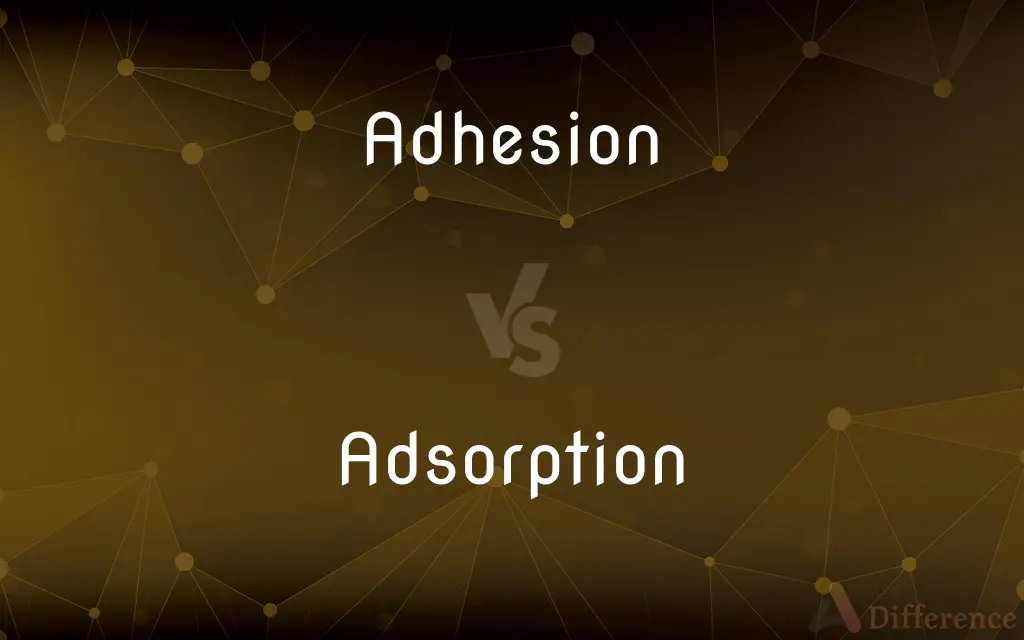Adhesion vs. Adsorption — What's the Difference?
By Tayyaba Rehman & Fiza Rafique — Updated on April 3, 2024
Adhesion involves the attraction between different substances, e.g., paint on a wall, while adsorption is the process where particles accumulate on a surface, like gas on charcoal.

Difference Between Adhesion and Adsorption
Table of Contents
ADVERTISEMENT
Key Differences
Adhesion is the process where two different materials stick together through intermolecular forces, such as water droplets on a leaf. On the other hand, adsorption refers to the accumulation of substances only at the surface of a material, like pollutants adhering to a filter.
Adhesion can occur through various mechanisms, including mechanical interlocking and chemical bonding, providing a versatile range of applications from medical adhesives to construction materials. Whereas, adsorption usually involves weaker physical bonds, such as van der Waals forces, making it crucial for processes like air and water purification.
The strength and permanence of adhesion can vary greatly, depending on the materials involved and the conditions of their interaction, which allows for both temporary and permanent bonds. Adsorption, on the other hand, is often reversible, which is advantageous for processes requiring regeneration of the adsorbent material, such as in gas masks.
In adhesion, the materials involved can undergo some degree of deformation or chemical change at the interface to enhance bonding. In contrast, adsorption involves no significant change in the adsorbent or adsorbate, preserving their original properties.
Adhesion is essential for the functionality of composite materials, where the bonding between different materials can significantly affect the composite's overall properties. Adsorption plays a key role in heterogeneous catalysis, where the reaction occurs on the surface of the catalyst, emphasizing the importance of surface properties.
ADVERTISEMENT
Comparison Chart
Nature of Interaction
Bonding between different materials.
Accumulation of particles at a surface.
Mechanism
Mechanical interlocking, chemical bonding.
Physical bonds (van der Waals forces).
Reversibility
Can be either permanent or temporary.
Usually reversible.
Change in Materials
Possible deformation or chemical change at the interface.
No significant change in properties.
Applications
Medical adhesives, construction materials.
Air and water purification, gas masks.
Compare with Definitions
Adhesion
The action of sticking to a surface or object.
The adhesion between paint and wood ensures a long-lasting finish.
Adsorption
A surface-based phenomenon without bulk material involvement.
Adsorption traps pollutants on the surface of a filter.
Adhesion
Can be influenced by the nature of the surfaces involved.
Surface treatments can enhance adhesion between metals and plastics.
Adsorption
Often used in purification and separation processes.
Adsorption techniques are employed in air purifiers to remove contaminants.
Adhesion
The force that holds molecules of different substances together.
Adhesion allows water droplets to cling to window glass.
Adsorption
The process by which atoms, ions, or molecules adhere to a surface.
Adsorption of dyes by activated charcoal is used in water treatment.
Adhesion
A process used in various industries for bonding materials.
In car manufacturing, adhesion techniques are crucial for assembling parts.
Adsorption
Utilizes physical or chemical adsorption mechanisms.
The adsorption of gases on metal surfaces is critical for catalysis.
Adhesion
Involves physical or chemical mechanisms.
The adhesion of glue to paper involves chemical bonds.
Adsorption
Reversible, allowing for regeneration of adsorbent materials.
Adsorbed chemicals can often be removed from adsorbents, allowing for reuse.
Adhesion
Adhesion is the tendency of dissimilar particles or surfaces to cling to one another (cohesion refers to the tendency of similar or identical particles/surfaces to cling to one another). The forces that cause adhesion and cohesion can be divided into several types.
Adsorption
Adsorption is the adhesion of atoms, ions or molecules from a gas, liquid or dissolved solid to a surface. This process creates a film of the adsorbate on the surface of the adsorbent.
Adhesion
The process or condition of sticking or staying attached
The adhesion of the glue to wood.
Adsorption
The accumulation of gases, liquids, or solutes on the surface of a solid or liquid.
Adhesion
(Physics) The physical attraction or joining of two substances, especially the macroscopically observable attraction of dissimilar substances.
Adsorption
The adhesion of a liquid or gas on the surface of a solid material, forming a thin film on the surface.
Adhesion
A condition in which bodily tissues that are normally separate grow together.
Adsorption
The process by which molecules of a substance form a thin film on the surface of a solid. Distinguished from absorption, in which the foreign substance penetrates the body of the absorbing material.
Adhesion
A fibrous band of scar tissue that binds together normally separate anatomical structures.
Adsorption
The accumulation of molecules of a gas to form a thin film on the surface of a solid
Adhesion
Attachment or devotion, as to a religion or belief.
Adhesion
The ability of a substance to stick to an unlike substance.
Adhesion
Persistent attachment or loyalty.
Adhesion
An agreement to adhere.
Adhesion
(medicine) An abnormal union of surface by the formation of new tissue resulting from an inflammatory process.
Adhesion
(biochemistry) The binding of a cell to a surface or substrate.
Adhesion
The frictional grip on a surface, of wheels, shoes etc.
Adhesion
The action of sticking; the state of being attached; intimate union; as, the adhesion of glue, or of parts united by growth, cement, or the like.
Adhesion
Adherence; steady or firm attachment; fidelity; as, adhesion to error, to a policy.
His adhesion to the Tories was bounded by his approbation of their foreign policy.
Adhesion
Agreement to adhere; concurrence; assent.
To that treaty Spain and England gave in their adhesion.
Adhesion
The molecular attraction exerted between bodies in contact. See Cohesion.
Adhesion
Union of surface, normally separate, by the formation of new tissue resulting from an inflammatory process.
Adhesion
The union of parts which are separate in other plants, or in younger states of the same plant.
Adhesion
Abnormal union of bodily tissues; most common in the abdomen
Adhesion
A fibrous band of scar tissue that binds together normally separate anatomical structures
Adhesion
The property of sticking together (as of glue and wood) or the joining of surfaces of different composition
Adhesion
Faithful support for a religion or cause or political party
Common Curiosities
What is adhesion?
Adhesion is the process where two different materials stick together through forces of attraction.
How does adsorption differ from adhesion?
Adsorption is the accumulation of particles on a surface, differing from adhesion, which involves bonding between different materials.
Can the strength of adhesion vary?
Yes, the strength of adhesion can vary greatly, influenced by the interacting materials and conditions.
What is a common use of adsorption in daily life?
A common use of adsorption is in water filters and air purifiers to trap contaminants.
Is adsorption reversible?
Yes, adsorption is usually reversible, which is beneficial for processes that require regeneration of the adsorbent.
Do both adhesion and adsorption involve chemical changes?
Adhesion may involve chemical changes at the interface, while adsorption usually does not alter the adsorbent or adsorbate significantly.
What role does adhesion play in industries?
Adhesion is crucial for various applications, including construction, manufacturing, and medical adhesives.
Can adsorption occur on all surfaces?
Adsorption can occur on many surfaces, especially those with high surface area and specific chemical properties.
Can adhesion be permanent?
Yes, adhesion can be either permanent or temporary, depending on the materials and mechanisms involved.
How do surface properties affect adhesion and adsorption?
Surface properties, such as roughness and chemical composition, significantly affect both adhesion and adsorption processes.
What distinguishes physical from chemical adsorption?
Physical adsorption involves weaker forces like van der Waals, whereas chemical adsorption involves stronger chemical bonds.
How is adsorption used in industrial applications?
Adsorption is used in industrial applications such as heterogeneous catalysis and purification processes.
How is adsorption utilized in environmental processes?
Adsorption is widely used in air and water purification processes to remove pollutants.
What is an example of adhesion in nature?
An example of adhesion in nature is water droplets sticking to plant leaves.
Are there different mechanisms for adhesion?
Yes, adhesion can occur through mechanisms like mechanical interlocking and chemical bonding.
Share Your Discovery

Previous Comparison
Comfort vs. Convenience
Next Comparison
Vinegarette vs. VinaigretteAuthor Spotlight
Written by
Tayyaba RehmanTayyaba Rehman is a distinguished writer, currently serving as a primary contributor to askdifference.com. As a researcher in semantics and etymology, Tayyaba's passion for the complexity of languages and their distinctions has found a perfect home on the platform. Tayyaba delves into the intricacies of language, distinguishing between commonly confused words and phrases, thereby providing clarity for readers worldwide.
Co-written by
Fiza RafiqueFiza Rafique is a skilled content writer at AskDifference.com, where she meticulously refines and enhances written pieces. Drawing from her vast editorial expertise, Fiza ensures clarity, accuracy, and precision in every article. Passionate about language, she continually seeks to elevate the quality of content for readers worldwide.















































